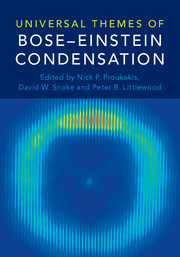Book contents
- Frontmatter
- Contents
- Foreword
- Preface
- Part I Introduction
- Part II General Topics
- Editorial Notes
- 5 The Question of Spontaneous Symmetry Breaking in Condensates
- 6 Effects of Interactions on Bose-Einstein Condensation
- 7 Formation of Bose-Einstein Condensates
- 8 Quenches, Relaxation, and Prethermalization in an Isolated Quantum System
- 9 Ultracold Gases with Intrinsic Scale Invariance
- 10 Berezinskii-Kosterlitz-Thouless Phase of a Driven-Dissipative Condensate
- 11 Superfluidity and Phase Correlations of Driven Dissipative Condensates
- 12 BEC to BCS Crossover from Superconductors to Polaritons
- Part III Condensates in Atomic Physics
- Part IV Condensates in Condensed Matter Physics
- Part V Condensates in Astrophysics and Cosmology
- Universal Bose-Einstein Condensation Workshop
- Contributors
- Index
- References
7 - Formation of Bose-Einstein Condensates
from Part II - General Topics
Published online by Cambridge University Press: 18 May 2017
- Frontmatter
- Contents
- Foreword
- Preface
- Part I Introduction
- Part II General Topics
- Editorial Notes
- 5 The Question of Spontaneous Symmetry Breaking in Condensates
- 6 Effects of Interactions on Bose-Einstein Condensation
- 7 Formation of Bose-Einstein Condensates
- 8 Quenches, Relaxation, and Prethermalization in an Isolated Quantum System
- 9 Ultracold Gases with Intrinsic Scale Invariance
- 10 Berezinskii-Kosterlitz-Thouless Phase of a Driven-Dissipative Condensate
- 11 Superfluidity and Phase Correlations of Driven Dissipative Condensates
- 12 BEC to BCS Crossover from Superconductors to Polaritons
- Part III Condensates in Atomic Physics
- Part IV Condensates in Condensed Matter Physics
- Part V Condensates in Astrophysics and Cosmology
- Universal Bose-Einstein Condensation Workshop
- Contributors
- Index
- References
Summary
The problem of understanding how a coherent, macroscopic Bose- Einstein condensate (BEC) emerges from the cooling of a thermal Bose gas has attracted significant theoretical and experimental interest over several decades. The pioneering achievement of BEC in weakly interacting dilute atomic gases in 1995 was followed by a number of experimental studies examining the growth of the BEC number, as well as the development of its coherence. More recently, there has been interest in connecting such experiments to universal aspects of nonequilibrium phase transitions, in terms of both static and dynamical critical exponents. Here, the spontaneous formation of topological structures such as vortices and solitons in quenched cold-atom experiments has enabled the verification of the Kibble-Zurek mechanism predicting the density of topological defects in continuous phase transitions, first proposed in the context of the evolution of the early universe. This chapter reviews progress in the understanding of BEC formation and discusses open questions and future research directions in the dynamics of phase transitions in quantum gases.
Introduction
The equilibrium phase diagram of the dilute Bose gas exhibits a continuous phase transition between condensed and noncondensed phases. The order parameter characteristic of the condensed phase vanishes above some critical temperature Tc and grows continuously with decreasing temperature below this critical point. However, the dynamical process of condensate formation has proved to be a challenging phenomenon to address both theoretically and experimentally. This formation process is a crucial aspect of Bose systems and of direct relevance to all condensates discussed in this book, despite their evident system-specific properties. Important questions leading to intense discussions in the early literature include the time scale for condensate formation and the role of inhomogeneities and finite-size effects in “closed” systems. These issues are related to the concept of spontaneous symmetry breaking, its causes, and implications for physical systems (see, for example, Chapter 5 by Snoke and Daley).
In this chapter, we give an overview of the dynamics of condensate formation and describe the present understanding provided by increasingly well-controlled cold-atom experiments and corresponding theoretical advances over the past twenty years. We focus on the growth of BECs in cooled Bose gases, which, from a theoretical standpoint, requires a suitable nonequilibrium formalism.
- Type
- Chapter
- Information
- Universal Themes of Bose-Einstein Condensation , pp. 117 - 150Publisher: Cambridge University PressPrint publication year: 2017
References
- 3
- Cited by

